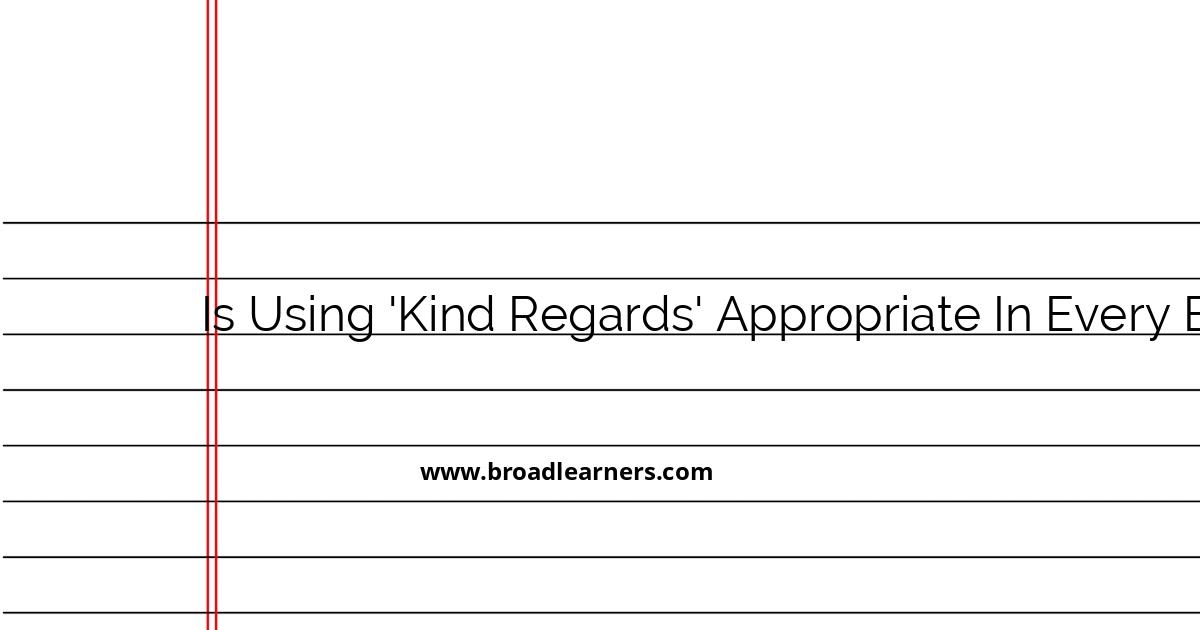The phrase 'Kind Regards' is a common closing signature used in email communication. However, not every situation warrants the use of this phrase. Its appropriateness largely depends on the context and the recipient of the email. In this article, we will discuss the appropriateness of using 'Kind Regards' and explore alternatives for different scenarios.
- When is 'Kind Regards' Appropriate?
-
'Kind Regards' is suitable when communicating in formal or semi-formal settings. It strikes the right balance between professionalism and warmth, making it an excellent choice for professional correspondence, such as emails to colleagues, acquaintances, clients, or service providers.
- When is 'Kind Regards' Not Appropriate?
-
In informal settings or emails where you're communicating with friends or family members, 'Kind Regards' may come across as overly formal or distant.
Example:
Dear Mr. Smith,
Thank you for the opportunity to discuss our collaboration. I look forward to the potential of working together.
Kind Regards,
Jane Doe
Example:
Hi Anna,
It was great catching up with you over coffee. Let’s plan another outing soon!
Best,
John
Alternatives to 'Kind Regards'
Below are some alternatives to 'Kind Regards' that you can consider using depending on the context:
- Sincerely: Use this when writing formal letters or emails. It conveys respect and could be ideal for business or job applications.
- Best Regards: A slightly less formal closing than 'Kind Regards', 'Best Regards' can be used in professional settings where you want to maintain a touch of informality.
- Warm Regards: This is more friendly and can be used for communications with colleagues or clients with whom you have an established relationship.
- Best: This is a versatile and informal closing suitable for both professional and personal emails. It adds a friendly tone without being too familiar.
- Cheers: An informal sign-off best used among peers or within casual professional circles. It implies a casual, upbeat tone.
- Thank you: Especially appropriate if the email's content involved a favor or assistance received.
Example:
Dear Hiring Manager,
Thank you for considering my application for the position. I am eager to bring my expertise to your team.
Sincerely,
Mark Anthony
Example:
Hi Laura,
Thank you for the feedback on our project proposal. I’ll ensure the updates are incorporated.
Best Regards,
Michael
Example:
Dear Sarah,
Thank you for your continued support throughout the last quarter. Your contributions have been invaluable.
Warm Regards,
Alice
Example:
Hey Tom,
Thanks for sharing the report. It’s really insightful!
Best,
Nancy
Example:
Hi James,
Looking forward to catching up at the conference next month!
Cheers,
Susan
Example:
Dear Miss Brown,
Thank you for providing the necessary documents for review at such short notice.
Thank you,
Robert
Choosing the right sign-off is a crucial aspect of email etiquette. While 'Kind Regards' is widely accepted, understanding the context and relationship with the recipient will help you decide if it, or any of its alternatives, is the right choice for your communication.

Did I miss anything? Respond below